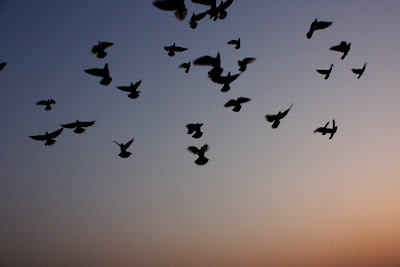8 November 2009
My resident chai wallah
A chai wallah has set up shop outside my house. This fact warms my heart like it warms the bellies of the labourers on my block. Everyday when I leave and when I came home, people are gathered around his chai trolly for milky sweet tea and conversation. I love the way people stand behind the hotplate with him, watching as he tosses tea and sugar in an arc from their containers into the boiling pot of milk. It's an elaborate and flambouyant process, transforming the mundane to something quite sophisticated - so sophistacated that his clients have a choice of drinking from a glass or taking their tea away in a plastic bag. I think he fears I might object to his presence so he stands up every time my car passes by. So not only does he add awesome street texture but he provides a daily boost to my ego. I don't recall being quite so polite when I was a coffee making student.
The importance of hills and oceans

It may be because I grew up on a hill, and have holidayed near an ocean every year, but I’m finding my psycho-topographical needs are not being met by the flat inland expanse of Delhi. A recent visit to Mumbai, which is blessed with both hills and ocean, reminded me of these invisible but visceral wants.
The Delhi of many kingdoms sits grandly in the middle of a vast plain, dissected by ancient rivers that have seen better days. But modern Delhi has succumbed to the bloating of the middle aged. Unconstrained by geography it has eaten all the pies, sprawled out into adjoining states, low density for the most, cars essential, and Delhites undertaking massive daily treks to get from A to B.
And because it is so big, and so flat and so low rise, there is nowhere in the city where you can get a decent view of the path ahead as you trundle around town. There are a few vantage points atop five star hotels. And the minaret in Jama Masjid has an amazing view over the rooftops of the old city. But most days are spent focusing on the immediate action at street level. There are charms to this, but for the most, it feels like a train ride in the dark – you can’t see where you’re going, or measure how far you’ve come. You’re just moving from one busy flat space to another.
Where Delhi has let itself go, Mumbai has been forced, by a chronic shortage of land, to build up. Mumbai is blessed with ocean (to gaze at) and hills (to gaze from). I know nobody would ever accuse Mumbai of being well planned, but the incidental views make it a much easy city to digest. And the higher density gives Mumbai a humanity (perhaps too much humanity) which the vastness of Delhi sometimes misses.
I have a controversial plan for Delhi, which is yet to find a seconder, and will require some fine tuning before I take out full page newspaper ads. Suffice to say it would ameliorate the topography issue by building up where previous generations built out (and perhaps importing a few hillocks). Those who know my views on Canberra will be utterly unsurprised by my ideas on what makes a city liveable.
Until I bring this plan to fruition (and given it involves the removal of politician housing on quarter acre blocks in the heritage sector of town, this is not so likely), I will just have to get my hill and ocean needs on weekend trips away.
The pigeon man of shahjahanabad


On a recent late summer evening, we were taken to meet one of old Delhi's (allegedly) famous pigeon racers. I've not really a pigeon person, but rising out of the clamour of old delhi to Mr Pigeon's quiet rooftop, as the sun dipped lazily over the horizon, was quite a nice moment. We climbed from the rear of a packaging shop, pungent with glues, up a dark spiralling staircase and emerged just as a flock of Iranian racing pigeons landed in synchronised formation. These were not your standard flying-rat pigeons, we were told, these were prestige pigeons! They had each been named after a different bollywood star, and of course Mr Bachchan was the biggest and pluckiest of the lot - demanding to dig his head into the scattered seeds before the rest. Mr Pigeon's son had learnt to speak pigeon and with clicks and whistles instructed the birds to rise into the air, to circle the platform a few times and then to return. Set against the pink sky, with the call to prayer echoing across the rooftops from Jama Masjid (the city mosque), this was a sight of delhi I won't forget in a hurry.
Sachin rules the dusk
Cricket: Everyone knows Indians love it. But I had a moment this week when it really, truly sunk in. I was walking home from my local shops, around dusk, in the latter stages of an Australia-India one day match. As I passed house after house, the guards were outside crouched around small radios in clusters, hanging on every word of the Hindi commentary. Cars drove by and spilled snatches of cricket out their windows. And in the shops people stood before televisions, halting work to take in the developments – passers-by peered inside for a score. On the field of battle itself, Sachin Tendulkar was tearing apart the Australian bowling attack and the whole country was hanging on every flash of his willow. It reminded me a little of Kathy Freeman’s run in the 2000 Olympics when the whole of Australia just stopped and watched and joined the moment. Magic.
Subscribe to:
Posts (Atom)




